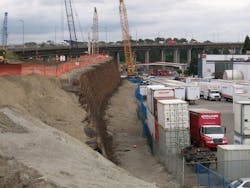One thing is for certain: British Columbia’s Port Mann/Highway 1 (PMH1) Improvement Project is a big deal. Launched in 2008, the five-year, $2.4 billion undertaking is a key initiative of the Ministry of Transportation and Infrastructure’s Gateway Program to address the Vancouver region’s burgeoning population and resulting increase in traffic. It includes the widening and upgrading of 23 miles of Highway 1—which leads into the city and currently serves more than 100,000 commuters daily—and the replacement of the nearly 50-year-old Port Mann Bridge.
The new Port Mann Bridge is one for the record books. Scheduled to open late this year, the 1.2-mile bridge across the Fraser River will double existing lanes from five to 10 and ultimately accommodate automobile traffic, bus and light rail transit, and cyclists. Once operational, the new bridge is projected to sustain Vancouver’s traffic growth over the next two decades. The entire project will be completed in 2013.
Divided into four segments, the PMH1 project includes more than two dozen Tensar Sierra slope retention systems and two SierraScape retaining wall system installations. The switch from the precast concrete walls that were initially specified resulted from a desire for more cost-efficient solutions with greener profiles. It began with a test installation in 2009—a 10-ft slope built to reinforce a ditch at the westbound lane of the Highway 1 road-widening site. It peaks with a massive slope running 774 ft in length, climbing to 30 ft in height, with nearly 21,528 sq ft of facing. That slope “takes us a couple of steps up the ladder in its level of design and sophistication,” said Dan MacDonald, P.E., manager for Nilex (Tensar Intl.’s distributor for Western Canada) at the company’s Burnaby office.
Switch to Slopes
In 2008, representatives from Kiewit/Flatiron General Partnership—the PMH1 project’s prime contractor—recognized the potential for an alternative to precast. They asked MacDonald, along with Tensar Regional Sales Manager John Kerr, P.E., and Regional Design Engineer German Cajigas, P.E., to review preliminary wall locations and look for opportunities for reinforced slopes. The three met with Kiewit/Flatiron’s Ryan Tones, P.E., and Ryan Bonnett, E.I.T.
“The original drawings showed vertical precast concrete walls, and we responded with conceptual drawings of slopes,” MacDonald said. Following Kiewit/Flatiron’s installation of the ditch reinforcement in 2009, additional slopes were approved. That included the Port Mann Bridge slope—but not before a rigorous evaluation of its proposed design.
Structural Analysis
Design criteria were indeed stringent—a slope had to accommodate a projected construction settlement of 15 in., a post-construction settlement of 8 in. and the ability to withstand a 975-year seismic event. Rising 30 ft, with a 69-degree inclination at the face, the slope was designed by Cajigas in conjunction with Nilex and with technical support from Tensar’s Ken Akins, P.E., Willie Liew, P.E., and Brendan Sheppard, P.E., all from the company’s Atlanta headquarters. “The initial design was typical,” Cajigas said, “but we significantly increased the factor of safety, integrating conventional design and numerical analysis to comply with the performance requirements.”
“That was the challenge,” he added. “After all, this was our tallest structure and the highest levels of seismicity that have ever undergone FLAC [Fast Lagrangian Analysis of Continua] analysis. We had to account for differential settlement, construction loading and the presence of the gantry crane on site.”
Seismic Performance
Geotechnical engineering firm MEG Consulting Ltd. was contracted to evaluate the geotechnical properties of the foundation soils and fill materials, including an assessment of the potential for liquefaction and slope response under the seismic loading design conditions. The slope design was analyzed using FLAC, the numerical modeling program that determines expected horizontal and vertical ground deformations as well as forces in the geogrid during and after a specified earthquake event. The analysis indicated the slope’s “flexible response” and its ability to withstand a 975-year seismic occurrence, maintaining the performance requirements established for the project.
Rising to the Challenge
With the design approved, ground improvement preceded installation of the slope. A series of stone support columns were first installed at a depth of 66 ft. Because concrete footings were not required, the area then was topped with a level granular surface. The Sierra System’s welded-wire facing units then were stepped from the granular foundation up and lined with Tensar biaxial geogrid; the soil was reinforced with the primary placement of Tensar uniaxial geogrid or with additional biaxial geogrid. The geogrid-reinforced zone required 14,387 cu yd of compacted granular or sand backfill, while the project required 65,398 cu yd of backfill overall.
To vegetate the slope, two products from Tensar North American Green were used: the P300 Permanent Turf Reinforcement Mat below the 200-year flood level line, and the C125 Erosion Control Blanket above. To promote internal drainage, a trench was installed within the slope, and drain gravel was placed within its lower portion. The slope transitions to a two-stage precast wall supporting bridge girders across the existing highway.
The Port Mann Bridge slope is sure to be “a highlight of Tensar’s portfolio,” Nilex’s MacDonald said. He also cited the Sierra System’s cost and environmental benefits, noting “green slope technology is beneficial to aquatic wildlife.” A number of Sierra Slopes are being used to construct fish culverts in the project’s creek areas as well.
Paul Glickstein is a contributing writer for Tensar Intl. Corp. Glickstein can be reached at [email protected] or 404.329.0206.
Download: Here


